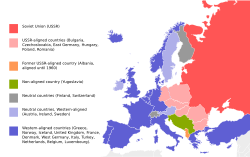
Back Oosblok Afrikaans الكتلة الشرقية Arabic Bloque del Este AST Şərq bloku Azerbaijani Източен блок Bulgarian পূর্ব ব্লক Bengali/Bangla Bloc de l'Est Catalan بلۆکی ڕۆژھەڵات CKB Východní blok Czech Y Bloc Dwyreiniol Welsh

| Eastern Bloc |
|---|
 |
The Eastern Bloc, also known as the Communist Bloc (Combloc), the Socialist Bloc, and the Soviet Bloc, was the collective term for an unofficial coalition of communist states of Central and Eastern Europe, Asia, Africa, and Latin America that were aligned with the Soviet Union and existed during the Cold War (1947–1991). These states followed the ideology of Marxism–Leninism, in opposition to the capitalist Western Bloc. The Eastern Bloc was often called the "Second World", whereas the term "First World" referred to the Western Bloc and "Third World" referred to the non-aligned countries that were mainly in Africa, Asia, and Latin America but notably also included former pre-1948 Soviet ally Yugoslavia, which was located in Europe.
In Western Europe, the term Eastern Bloc generally referred to the USSR and Central and Eastern European countries in the Comecon (East Germany, Poland, Czechoslovakia, Hungary, Romania, Bulgaria, and Albania).[a] In Asia, the Eastern Bloc comprised Mongolia, Vietnam, Laos, Kampuchea, North Korea, South Yemen, Syria, and China.[b][c] In the Americas, the countries aligned with the Soviet Union included Cuba from 1961 and for limited periods Nicaragua and Grenada.[1]
Cite error: There are <ref group=lower-alpha> tags or {{efn}} templates on this page, but the references will not show without a {{reflist|group=lower-alpha}} template or {{notelist}} template (see the help page).
- ^ Piero Gleijeses, Conflicting Missions: Havana, Washington, and Africa, 1959–1976, ISBN 978-0-8078-5464-8.